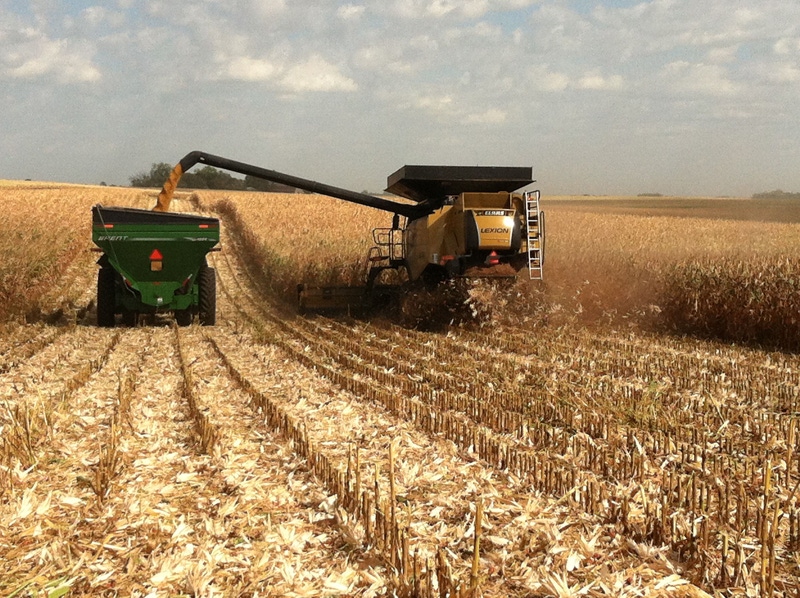September 12, 2012

According to the WASDE report released on Sept. 12, 2012, USDA has lowered U.S. corn and soybean production by more than 50 million bushels for each commodity. Corn prices dropped 30¢/bu. on each end of the spectrum; soybean prices remain unchanged at $15-17/bu.
Corn
U.S. feed grain supplies for 2012-2013 are projected higher this month with a reduction in forecast corn production more than offset by higher projected corn carry-in. U.S. corn production is lowered 52 million bushels with the national average yield forecast 0.6 bu./acre lower at 122.8 bu.. Lower yields and production in the Corn Belt and Central Plains are partly offset by increases elsewhere, particularly across the South where an early harvest is boosting available supplies.
U.S. corn supplies for 2012-2013 are projected 108 million bushels higher as an increase in expected beginning stocks more than offsets lower production this month. Exports for 2011-2012 are lowered 10 million bushels reflecting the slowing pace of shipments during August. Feed and residual use for 2011-2012 is lowered 150 million bushels based on the record level of crop maturity and harvest progress as of Sept. 1. State-level crop progress reports indicate that nearly 11% of the 2012 corn crop was harvested before the Sept. 1 start of the 2012-2013 marketing year. Based on state-by-state production forecasts from the Sept. 12 Crop Productionreport, nearly 1.2 billion bushels of new-crop corn are estimated to have been available for use before the end of the old-crop 2011-2012 marketing year. This is up more than 700 million bushels from a year ago. Early new-crop corn use is expected to displace use of 2011 old-crop corn and boost old-crop inventories on Sept. 1. As a result, early new-crop usage reduces the feed and residual calculation in the balance sheet. (For a more complete discussion see Westcott and Norton, Implications of an Early Corn Crop Harvest for Feed and Residual Use Estimates (pdf), FDS-12F-01, Economic Research Service, USDA, July 2012.)
Total U.S. corn use for 2012-2013 is raised this month with higher expected feed and residual disappearance more than offsetting lower projected exports. Feed and residual disappearance is projected 75 million bushels higher, in part reflecting higher expected September-December disappearance with the expected rise in early new-crop usage during the 2011-2012 marketing year. Exports for 2012-2013 are projected 50 million bushels lower with increased competition from lower-priced South American supplies. Ending stocks for 2012-2013 are projected 83 million bushels higher at 733 million. The projected range for the corn season-average farm price is lowered 30¢ on both ends of the range to $7.20-8.60/bu.
Global coarse grain supplies for 2012-2013 are projected 4.0 million tons lower despite higher beginning stocks of corn in the United States and barley in Canada. Reduced corn production prospects for EU-27, Serbia and Canada add to the decline in the United States to reduce world corn output 8.0 million tons. Corn production is lowered 4.4 million tons for EU-27 with yield reductions for France, Italy, Romania and Hungary as extended drought and heat in August further reduced production prospects across southern Europe. Serbia production is also lowered 1.2 million tons reflecting the same adverse weather conditions. Canada corn production is lowered 1.1 million tons based on the latest survey results from Statistics Canada.
Global 2012-2013 corn exports are lowered 1.8 million tons this month with the largest reduction for the United States. Corn exports are also lowered for Serbia and EU-27. Partly offsetting these reductions is a 1.0-million-ton increase for Brazil exports. Foreign coarse grain consumption is lowered mostly on lower corn usage. Corn feeding is lowered 4.0 million tons for the EU-27, 1.0 million tons for Canada and 0.4 million tons for Serbia. Corn feeding is raised 0.8 million tons for Egypt. Global corn ending stocks are projected 0.6 million tons higher with the increase for the United States partly offset by a reduction for Brazil.
Soybeans
U.S. oilseed production for 2012-2013 is projected at 82 million tons, down 1.4 million from last month. Lower soybean and cottonseed production is only partly offset by an increase for peanuts. Soybean supplies for 2012-2013 are reduced due to lower forecast production and beginning stocks. Soybean production is projected at 2.634 billion bushels, down 58 million due to lower yields in the Midwest. Soybean exports are reduced 55 million bushels to 1.055 billion mainly due to reduced supplies. Soybean crush is reduced 15 million bushels to 1.5 billion, the lowest since 1996-1997. The reduction reflects lower projected soybean meal exports and domestic soybean meal consumption. Although soybean ending stocks are projected unchanged at 115 million bushels, they would fall to a nine-year low. Other changes for 2012-2013 include reduced soybean oil production and ending stocks.
Soybean crush for 2011-2012 is increased 15 million bushels to 1.705 billion reflecting higher-than-expected crush reported for July. Soybean exports are increased 10 million to 1.36 billion. Residual use is lowered 10 million bushels reflecting the impact of early harvest of the 2012-2013 crop in the South. Ending stocks are projected at 130 million bushels, down 15 million from last month. Other changes for 2011-2012 include increased soybean oil production, exports, and ending stocks and increased domestic disappearance of soybean meal.
The U.S. season-average soybean price for 2012-2013 is projected unchanged at $15-17/bu. Soybean meal prices are projected at $485-515/short ton, up $25 on both ends of the range. Soybean oil prices are projected at 54-58¢/lb., up 1¢ on both ends of the range.
Global oilseed production for 2012-2013 is projected at 453.1 million tons, down 4.2 million from last month. Reductions for soybeans, sunflowerseed and rapeseed are only partly offset by increased peanut and cottonseed production. In addition to the United States, projected soybean production is reduced for Ukraine and Canada. Early harvest results for Ukraine indicate a lower yield in part reflecting unusually hot temperatures during the growing season. Lower soybean production for Canada is based on the most recent crop survey results reported by Statistics Canada.
You May Also Like




